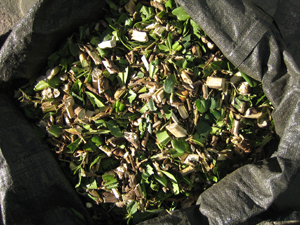 |
 |
 |
When it's time for pruning, all gardens are filled with branches that, together, can achieve a critical mass. These branches may have different destinations: wood used in fireplaces and barbecues, they can go to the green dot, be deposited in special containers (if any), stacked in the street (with all what that entails: collection, nuisance to neighbors, sense of complacency, etc.), or serve as a dry material into the composter. In the last case, pruning becomes crucial. This material has a number of features that make it ideal for a good compost, but needs a defendant.
The various functions performed by the pruning inside the composter are:
- Absorbs water in excess provided by other materials such as grass or kitchen waste.
- Helps maintaining the balance between the amount of carbon and nitrogen. Both are essential nutrients that must be in suitable proportions in the composting process when it is correct. The pruning remains contribute with more carbon and help to compensate the remains with high nitrogen content, such as cooking remains, grass clippings or manure.
- Adds volume to compost.
- It provides spongy substance, which allows a better air circulation and makes the process to take place in the presence of oxygen.
However, to accomplish all these functions it is necessary that the branches are cut into small fragments. Grinding is not required for compost, but it really helps.
Some of the reasons for grinding:
- The prunings are very bulky. The reason is the stack, which is very compact and leaves many gaps. When the remains are crushed, the smaller fragments can be pieced together between them, which greatly reduces the volume.
- If not broken branches are introduced into the compost, they cause excessive drying, bulking and a reduction in the r conversion rate of organic matter.
- The size of the fragments is of great importance in the organic matter rate conversion, because if the size is large, bacteria and fungi have little penetrating power and can only grow almost on its outer surface. If it's too grinded, on the other hand, it can also be detrimental.
- An object in a whole piece has a lot less surface than the same shredded object, which will have more space on which to grow bacteria and fungi, which involves an increased rate of decomposition. The ideal size for the branches remains should be 5-15cm.
- During the compsoter routine maintenance there should be remains flipping to homogenize and aerate. If the fragments are large, the dump is much more laborious than if the material is crushed.
To carry out the shredding of prunings a shredder can be used.
